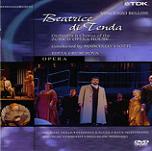Premiered in Venice in 1833 with Giuditta Pasta (the original Norma) in the title role, Beatrice di Tenda was greeted luke-warmly, but it became successful almost immediately thereafter. The librettist, Felice Romani, blamed its failure on Bellini’s lateness in delivering the score; the two men never worked together again. It soon was seen in Naples, Milan, and London and got to New Orleans in 1842 and New York in 1844. It re-emerged in Catania in 1935, Palermo in ’59, and in New York (in concert) in ’61 (with Sutherland and Horne), and then at La Scala, again with Sutherland. Since then it has appeared sporadically, when a soprano suited to it (and with enough clout) wants it. Despite some beautiful melodies, exciting cabalettas, and probably the most glorious trio Bellini ever composed, it is the most overlooked of his mature operas–its lack of a juicy tenor role (or mezzo role, for that matter) and dark hue may be to blame.
The plot: In 1418, outside of Milan, noblewoman Beatrice is accused of infidelity by her husband, Filippo, Duke of Milan, who is in love with her lady-in-waiting Agnese, who is in love with Orombello, who is in love with Beatrice. Trumped-up charges and a forced confession lead to Orombello’s and Beatrice’s eventual execution. (The plot is painfully like Donizetti’s Anna Bolena, although Filippo vascillates, Agnese is more culpable than Jane Seymour, and the courtiers are nastier here, encouraging Filippo to torture Beatrice.)
It’s an unpleasant little story, and it could happen anywhere and anytime that rich, powerful despots reside, as this Zurich Opera DVD production from December, 2001, makes clear. The sets and costumes, by Bernhard Kleber and Florence Von Gerkan, respectively, belong in that “anywhere” of the Art-deco period. The revolving set consists mostly of staircases and columns (and fractured, angular lighting effects stage rear), with the occasional stunning 1920s/’30s accoutrement: a fan-shaped vase or two, something Lalique. The look is ravishing, the best of late-1930s cinema, even if an occasional misty scrim with a ghostly figure painted on it doesn’t add anything to the mix. The courtiers are in formal dress, Agnese is in slithery crimson, Beatrice in incredibly high fashion–classy, noble, elegant–and doomed (her gown is crimson by the second act). It’s stunning and not at all anachronistic, except that in the trial scene a handful of courtiers crawl around wearing false, pointy noses. The direction, by Daniel Schmid, tends to reserved melodrama–so reserved that after Orombello is tortured into a false confession he still looks just fine.
Soprano Edita Gruberova recorded the title role in 1992 (Nightingale); here, nine years later, her portrayal is deeper and more tragic. As she is not a natural actress, the stylization helps her immensely, and though the voice may not be quite as fresh, she’s still astounding in her coloratura and amazing high notes. Her ability to spin out long phrases, her messa di voce on a high-C, her slightly flat landing on high-E (after some unpleasant and habitual upward swooping) which by note’s end she corrects through sheer technique are all an object lesson in singing.
Bellini has given Filippo remarkably beautiful music for a villain; his second-act scena makes us feel for him. Michael Volle smudges a run or two and could use more legato, but he sings with genuine feeling and stylish pianissimos. Stefania Kaluza has an impressive mezzo as Agnese, but it’s a bit rough-edged. Neither she nor the otherwise handsome-toned tenor Raul Hernandez should ever consider another high-C, as they both do (ruefully) at the end of their first-act duet. The chorus, with plenty to do, is excellent–the singers seem to have personalities–and the orchestra is superb. Marcello Viotti (who appears in a somewhat informative special-feature interview that begins as a fine discussion of Bellini and the bel canto and winds up being an advertorial for Mme Gruberova, making you wonder who works for whom) leads with authority and fine rhythmic verve, avoiding the oom-pah-pah aspects of the score.
The DVD picture is crystal clear; the sonics, after a few bouncy moments in Act 1, are big and true. The direction for video, by Yves André Hubert, allows us to experience the stunning overall look and also knows when to focus on whom in ensembles. Subtitles are in English, Spanish, French, and Italian. In all, this makes a good case for the opera, but interested parties also may want to hear Sutherland and Pavarotti (his first complete opera recording) on Decca.
































